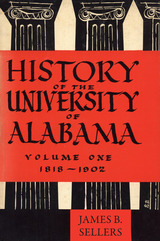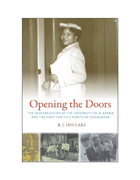2 books about University Alabama

History of the University of Alabama
Volume One, 1818-1902
James Benson Sellers
University of Alabama Press, 1953
The University of Alabama, established in 1831, has survived poverty, riots, political interference, wartime destruction, attacks by clergy and laymen, and internal feuds to develop from a boarding school for planters’ sons to a modern and thriving state university. Using official records and state newspapers as well as letters and diaries of presidents, students, teachers, and alumni, this comprehensive volume that covers 1818 to 1902 reveals the hardships and achievements of the men and women who made the university during its early years.
The History of the University of Alabama, first published in 1953, details the educational progress in spite of meager funds, primitive buildings and equipment, unruly students, and interruption by the Civil War. Interwoven with the accounts of campus life, extracurricular activities, early intercollegiate athletics, and building programs is the history of a long-sustained effort by many devoted presidents, faculty, and citizens to raise educational standards and to improve the instruction provided for the youth of the state.
[more]

Opening the Doors
The Desegregation of the University of Alabama and the Fight for Civil Rights in Tuscaloosa
B. J. Hollars
University of Alabama Press, 2013
Opening the Doors is a wide-ranging account of the University of Alabama’s 1956 and 1963 desegregation attempts, as well as the little-known story of Tuscaloosa, Alabama’s, own civil rights movement.
Whereas E. Culpepper Clark’s The Schoolhouse Door remains the standard history of the University of Alabama’s desegregation, in Opening the Doors B. J. Hollars focuses on Tuscaloosa’s purposeful divide between “town” and “gown,” providing a new contextual framework for this landmark period in civil rights history.
The image of George Wallace’s stand in the schoolhouse door has long burned in American consciousness; however, just as interesting are the circumstances that led him there in the first place, a process that proved successful due to the concerted efforts of dedicated student leaders, a progressive university president, a steadfast administration, and secret negotiations between the U.S. Justice Department, the White House, and Alabama’s stubborn governor.
In the months directly following Governor Wallace’s infamous stand, Tuscaloosa became home to a leader of a very different kind: twenty-eight-year-old African American reverend T. Y. Rogers, an up-and-comer in the civil rights movement, as well as the protégé of Martin Luther King Jr. After taking a post at Tuscaloosa’s First African Baptist Church, Rogers began laying the groundwork for the city’s own civil rights movement. In the summer of 1964, the struggle for equality in Tuscaloosa resulted in the integration of the city’s public facilities, a march on the county courthouse, a bloody battle between police and protesters, confrontations with the Grand Wizard of the Ku Klux Klan, a bus boycott, and the near-accidental-lynching of movie star Jack Palance.
Relying heavily on new firsthand accounts and personal interviews, newspapers, previously classified documents, and archival research, Hollars’s in-depth reporting reveals the courage and conviction of a town, its university, and the people who call it home.
[more]
READERS
Browse our collection.
PUBLISHERS
See BiblioVault's publisher services.
STUDENT SERVICES
Files for college accessibility offices.
UChicago Accessibility Resources
home | accessibility | search | about | contact us
BiblioVault ® 2001 - 2024
The University of Chicago Press









